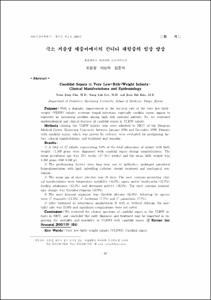극소 저출생 체중아에서의 칸디다 패혈증의 임상 양상
- Keimyung Author(s)
- Lee, Sang Lak; Kim, Joon Sik
- Department
- Dept. of Pediatrics (소아청소년학)
- Journal Title
- 대한신생아학회지
- Issued Date
- 2000
- Volume
- 7
- Issue
- 2
- Abstract
- Purpose: With a dramatic improvement in the survival rate oft he very low-birthweight (VLBW) infants, systemic fungal infections, especially candida sepsis, appear to represent an increasing problem among high risk neonatal patients. So, we evaluated epidemiological and clinical features of candidal sepsis in VLBW infants.
Methods: Among the VLBW infants who were admitted to NICU of the Dongsan Medical Center, Keimyung University between January 1996 and December 1999. Patients with candidal sepsis, which was proven by cultures, were evaluated for prediposing factors,
clinicalmanifestations,andtreatmentandsequelae.
Results:
1) A total of 22 infants, representing 9.6% of the total admissions of infants with birth weight <1,500 gram were diagnosed with candidal sepsis during hospitelizations. The mean gestational age was 29.5 weeks (27-36.3 weeks) and the mean birth weight was 1,260gram (860-1,480g).
2) The predisposing factors were long-term use of antibiotics, prolonged parenteral hyperalimentation with lipid, indwelling catheter, steroid treatment and mechanical ventilation.
3) The mean age of onset infection was 48 days. The most common presenting clinical manifestations were temperature in stability (46.2%), apnea and/or bradycardia (42.3%), feeding intolerance (42.3%), and decreased activity (38.5%). The most common hematologic change was thrombocytopenia(53.9%).
4) The most frequent organism was Candida albicans (65.4%), following by species were C. tropicalis (11.5%), C.l usitaniae (7.7%) and C. parasilosis (7.7%).
5) After treatment of intravenous amphotericin B with or without diflucan, the mortality rate was 13.6% and significant complications were not noted.
Conclusion: We reviewed the clinical spectrum of candidal sepsis in the VLBW infants in NICU, and concluded that early diagnosis and treatment may be important in improving the mortality and morbidity of VLBWI with candidal sepsis.
목 적 :신생아 집중 치료의 발달로 VLBWI의 생존률이 증가되면서 진균 감염이 증가하고 있어 저자들은 VLBWI에서 전신적 칸디다 감염의 임상 양상과 역학 등을 살펴보아 향후 이들의 진단과 치료에 도움을 주고자 이 연구를 시행하였다.
방 법 :1996년 1월에서 1999년 12월까지 계명대학교 의과대학 동산의료원 신생아 집중 치료실에 입원하였었던 VLBWI중 혈액 배양에서 진균 감염이 증명되었던 환아를 후향적으로 감염의 선행 요인, 감염 당시의 증상, 혈액학적 변화 등을 관찰하였다.
결 과 :228례의 VLBWI중 22례(9.6%)의 환아에게서 진균 감염이 있었으며 총 26건이었다.총 26건 중 감염 당시 경정맥 영양, 항생제 사용, 정맥내 도관, 인공 호흡기 사용, 스테로이드 사용은 각각 24례(92.3%), 19례(73.0%), 16례(61.5%), 10례(38.5%), 8례(30.8%)이었다. 전례에서 진균 감염 전에 광범위 항생제를 받은 경력이 있었으며 이전에 사용한 항생제 사용 기간은 평균 22.8±9.1일이었다. 감염의 시기는 출생 후 평균 48.3일이었고 임상 증상으로는 체온 불안정 12례(46.2%), 무호흡, 서맥과 수유 장애가 각각 11례(42.3%)가 가장 많았고 가장 뚜렷한 혈액학적 변화는 혈소판 감소 14례(53.9%)이었다.검출된 진균을 보면 Candidaalbicans17례(65.4%)가 가장 많았고 그 외 C.tropicalis, C.lusitaniae, C.parasilosis등이 검출되었다. 증상이 있은 후 항진균제 치료 시작일은 평균 4일(0-9일)이었다.치료 전 사망한 1례를 제외한 25례에서 amphotericin B를 사용하였으며 항진균제의 평균 사용 기간은 12.8±2.8일이었고 추적 배양 검사상 균이 검출되지 않은 시기는 약제사용 후 평균 4.5±2.8일이 지나서였다.3례(13.6%)에서 진균 감염에 의해 사망하였다.
결 론 :장기간 입원이 필요한 VLBWI에서 진균감염이 증가하고 있으므로 세균 감염과 유사한 증상을 보이면서 항생제 치료에 반응이 없는 경우 진균감염을 의심하여 조기에 항진균제를 사용하는 것이 VLBWI의 사망률을 줄일 수 있을 것으로 사료된다.
- Alternative Title
- Candidal Sepsis in Very Low-Bith-Weight Infants : Clinical Manifestations and Epidemiology
- Publisher
- School of Medicine
- Citation
- 조윤정 et al. (2000). 극소 저출생 체중아에서의 칸디다 패혈증의 임상 양상. 대한신생아학회지, 7(2), 97–104.
- Type
- Article
- ISSN
- 1226-1513
- Appears in Collections:
- 1. School of Medicine (의과대학) > Dept. of Pediatrics (소아청소년학)
- 파일 목록
-
-
Download
 oak-bbb-1946.pdf
기타 데이터 / 313.52 kB / Adobe PDF
oak-bbb-1946.pdf
기타 데이터 / 313.52 kB / Adobe PDF
-
Items in Repository are protected by copyright, with all rights reserved, unless otherwise indicated.